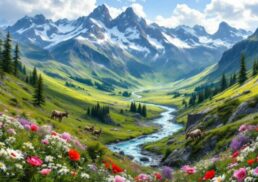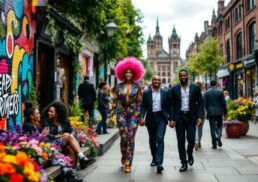Wondering what the New York City area has to offer? From iconic landmarks to diverse neighborhoods, NYC is a dynamic place waiting to be explored. This guide covers top attractions, notable neighborhoods, and practical tips for visitors and residents alike.
Table of Contents
Key Takeaways
New York City comprises five distinct boroughs—Manhattan, Brooklyn, Queens, The Bronx, and Staten Island—each contributing unique cultural and historical significance.
The city is renowned for its major landmarks such as the Statue of Liberty, Times Square, and Broadway, which embody its rich history and vibrant cultural scene.
Despite high housing costs, NYC’s diverse neighborhoods offer residents a variety of living experiences, supported by an efficient public transportation system facilitating accessibility throughout the city.
Overview of the New York City Area

New York City, a bustling urban center, exudes constant energy and vibrant atmosphere.
Spanning around 305 square miles (790 square km), NYC boasts a metropolitan population of over 20 million.
The city’s allure includes:
its diverse neighborhoods
iconic landmarks
delectable cuisine
efficient transportation
Making it a top travel destination.
Located in southeastern New York State, NYC is the northernmost major city in the north american continent, featuring a humid subtropical climate. NYC’s landscape mixes historic buildings, modern skyscrapers, and green spaces like Central Park, catering to diverse preferences in accommodations. The rich cultural fabric and continuous evolution of NYC make it one of the world’s most diverse and dynamic cities.
Exploring NYC’s neighborhoods, from Manhattan’s bustling streets to Staten Island’s serene parks, reveals the distinct charm of each borough. The scenic beauty of the Hudson River and New York Harbor, along with landmarks like the Statue of Liberty, symbolize freedom and democracy.
Our journey continues with an in-depth look at the five boroughs that define this vibrant city.
The Five Boroughs of NYC

New York City, known as the Big Apple, comprises five distinct boroughs: Manhattan, Brooklyn, Queens, The Bronx, and Staten Island. Each borough contributes uniquely to the city’s rich tapestry, from Manhattan’s glitz to Brooklyn’s artistic vibe and Queens’ cultural diversity.
Manhattan, the heart of NYC, hosts iconic landmarks such as Central Park and Times Square. Brooklyn charms with its trendy neighborhoods and vibrant arts scene. Queens is notable for its ethnic diversity and cultural landmarks. The Bronx features rich history and green spaces, whereas Staten Island offers a suburban feel with scenic harbor views.
Manhattan Highlights
Manhattan, the dynamic core of New York City, is synonymous with its iconic skyline and bustling streets. Central Park, a sprawling 840-acre oasis, offers a refreshing escape from the urban environment. From leisurely strolls to boat rides on the lake or visiting the Central Park Zoo, this park exemplifies the city’s dedication to preserving green spaces.
Midtown Manhattan epitomizes modernity with its iconic skyscrapers and vibrant atmosphere. Landmarks such as the Empire State Building and Rockefeller Center, towering symbols of architectural prowess, are found here. Times Square’s hustle, bright lights, and continuous motion capture NYC’s defining energy.
In contrast, Lower Manhattan is steeped in history and significance. Home to the World Trade Center site, this area poignantly reminds of the city’s resilience and strength. The financial district, anchored by Wall Street, underscores Manhattan’s role as a global financial hub. Exploring Lower Manhattan reveals both the historical roots and modern dynamism of New York City.
Brooklyn’s Charm
Brooklyn exudes a charm that is both eclectic and inviting. Brooklyn, known for its thriving arts scene, is a haven for creatives and art enthusiasts. Bushwick, renowned for its vibrant street art and galleries, transforms the borough into an open-air museum. Murals and installations infuse Brooklyn’s streets with color and character, reflecting its artistic spirit.
Williamsburg, another Brooklyn gem, is celebrated for its indie music scene and vintage shopping. A cultural hotspot, this neighborhood attracts visitors with trendy boutiques, live music venues, and artisanal eateries. Its infectious energy makes it a must-visit for those seeking Brooklyn’s unique vibe.
Brooklyn embodies diversity and creativity beyond its artistic and cultural offerings. Brooklyn’s neighborhoods, a mosaic of cultures and communities, contribute to its rich tapestry. From Park Slope’s historic brownstones to Flatbush’s bustling markets, Brooklyn’s charm lies in blending old with new, creating a dynamic and welcoming borough.
Queens: Diversity at Its Best
Queens, another of NYC’s five boroughs, is celebrated for its unparalleled diversity. As the world’s most ethnically diverse urban area, Queens is a microcosm of global cultures. This diversity vividly reflects in its neighborhoods, offering myriad cultural influences and cuisines.
Flushing Meadows-Corona Park, a central recreational hub in Queens, offers various cultural and recreational activities. Home to the iconic Unisphere, symbol of the 1964 World’s Fair, the park serves as a vibrant community space for residents and visitors to engage in various activities.
Exploring Queens offers a unique opportunity to immerse in a rich tapestry of cultures and experiences.
Major Landmarks and Attractions

New York City is famous for its major landmarks and attractions, drawing millions of visitors annually. From Manhattan’s towering skyscrapers to cultural institutions across the boroughs, NYC offers a wealth of sights. The city’s landmarks symbolize its history, culture, and spirit, beyond being mere tourist attractions.
Must-visit sites include the Statue of Liberty and Ellis Island, symbolizing freedom and democracy. Times Square and Broadway represent the city’s vibrant entertainment and cultural scene.
These landmarks, among many others, shape NYC’s unique identity, making it a top global travel destination.
Statue of Liberty and Ellis Island
Standing tall on Liberty Island, the Statue of Liberty is an enduring symbol of freedom and democracy. Gifted by France in 1886, this iconic statue celebrates the enduring relationship between the two nations and serves as a beacon of hope for arriving immigrants. Visiting the Statue of Liberty offers a profound glimpse into America’s history and values.
Nearby Ellis Island complements the story of the Statue of Liberty. Serving as the gateway for millions of immigrants from 1892 to 1954, Ellis Island chronicles the diverse journeys of those seeking a new life in America. The Ellis Island museum offers an immersive experience, tracing the footsteps of ancestors and understanding immigration’s profound impact on the nation.
Times Square and Broadway
Often called “The Crossroads of the World,” Times Square is a bustling hub attracting about 50 million visitors annually. Famous for its bright neon lights and electrifying atmosphere, Times Square epitomizes NYC’s vibrant energy. Whether enjoying sights, street performances, or people-watching, Times Square offers a unique experience.
Adjacent to Times Square lies Broadway, the heart of American theater. Hosting 41 professional theaters, Broadway is synonymous with high-quality theater and has been central to American culture since the 19th century. Broadway’s offerings, from classic plays to contemporary musicals, cater to a diverse audience, making it a must-visit for theater enthusiasts.
Combining Times Square’s dynamic environment with Broadway’s cultural significance creates a unique blend of entertainment and excitement. Visitors can enjoy a Broadway show and then step out into Times Square’s dazzling lights, experiencing the best of NYC. This area embodies the spirit of the Big Apple, showcasing its blend of tradition and modernity.
Historical Evolution of NYC
New York City’s history is a rich tapestry of transformation and resilience. Established as New Amsterdam by the Dutch West India Company in 1624, the settlement later relocated to Manhattan. In 1664, the British took control and renamed it New York City, marking its evolution into a major urban center.
The 1898 consolidation of the five boroughs was pivotal, expanding the city to 360 square miles and over 3.3 million residents. This expansion laid the foundation for today’s modern city, with diverse neighborhoods, bustling commercial districts, and iconic landmarks.
Throughout its history, NYC has been a significant center for numerous cultural and political reform movements shaping American history. From the abolitionist movement to the women’s suffrage campaign, NYC has played a crucial role in advocating for social change and justice. The city’s rich heritage is reflected in its many historical landmarks and institutions.
The September 11 attacks in 2001 were a defining moment in New York City’s history, leading to significant changes in both security and urban policy. The resilience and unity demonstrated by New Yorkers in the aftermath of the attacks highlighted the city’s enduring spirit. Today, the rebuilt World Trade Center stands as a symbol of hope and renewal, representing the city’s ability to overcome adversity and emerge stronger.
Economic Powerhouse
New York City is recognized as the largest urban economy in the United States, with a combined GDP of approximately $2.2 trillion in 2023. The city’s economic landscape is dominated by the financial services sector, which accounts for a significant portion of its GDP. The New York Stock Exchange and NASDAQ, the world’s largest stock exchanges, are located here, underscoring NYC’s role as a global financial hub.
Beyond finance, New York City is home to various leading industries, including healthcare, professional services, retail trade, and manufacturing. These industries contribute to the city’s economic diversity and resilience, providing employment opportunities for millions of residents. The average salary in New York’s securities industry is notably high, reflecting the lucrative nature of this sector.
The Erie Canal, completed in 1825, was a significant milestone in NYC’s economic history, facilitating trade with the hinterlands and boosting the city’s growth. Today, New York City’s economic strength continues to attract businesses and talent from around the world, solidifying its position as a powerhouse on the global stage.
Cultural and Contemporary Life

New York City is often referred to as a global hub for finance, media, art, and culture. Its cultural landscape is a vibrant mix of artistic expressions, musical genres, and culinary delights. From the artistic communities of Brooklyn to the ethnic neighborhoods of Queens, NYC offers a rich tapestry of cultural experiences that reflect its diversity and creativity.
Broadway is synonymous with American theater, featuring 41 professional theaters that host a wide range of performances. The high-quality productions on Broadway have been a central part of American theater culture since the 19th century, attracting audiences from around the world. Whether you’re a fan of classic plays or contemporary musicals, Broadway offers something for everyone.
Food tours in New York City provide immersive experiences that allow visitors to explore the city’s culinary offerings across the boroughs. From street food to high-end restaurants, NYC’s dining scene is as diverse as its population. This section will delve deeper into the city’s museums, galleries, and dining options, showcasing the best of its cultural and contemporary life.
Museums and Galleries
New York City is home to some of the world’s most renowned museums and galleries, making it a cultural epicenter for art enthusiasts. The Museum of Modern Art (MoMA) is one such institution, known for its impressive collection of contemporary art. Visitors can explore works by iconic artists such as Van Gogh, Picasso, and Warhol, experiencing the evolution of modern art firsthand.
In addition to MoMA, NYC boasts numerous other cultural landmarks, including the American Museum of Natural History and the Metropolitan Museum of Art. These institutions offer free admission on certain days, making art and culture accessible to all.
Whether you’re a history buff or an art lover, New York City’s museums and galleries provide a wealth of knowledge and inspiration.
Dining in NYC
New York City’s dining scene is a culinary adventure like no other. From the high-end restaurants of the Upper East Side to the cozy neighborhood eateries scattered throughout the five boroughs, NYC offers something for every palate. The city’s diverse population is reflected in its food, with global flavors and culinary traditions from around the world represented in its restaurants.
One of the best ways to experience NYC’s culinary diversity is through food tours, which provide immersive experiences that allow diners to engage with the food and culture in unique ways. Whether you’re sampling dim sum in Chinatown, enjoying a slice of pizza in Little Italy, or exploring the vibrant food markets of Queens, these tours offer a taste of the city’s rich culinary heritage.
For those looking for unique dining experiences, NYC does not disappoint. From rooftop bars with stunning views of the skyline to hidden speakeasies and trendy pop-up restaurants, the city is constantly reinventing itself. This dynamic dining scene ensures that no two meals are ever the same, making every dining experience in New York City an unforgettable adventure.
Parks and Recreation
New York City’s parks and recreational areas provide much-needed green spaces amidst the urban landscape. Central Park, recognized as America’s first public park, is a prime example of the city’s commitment to creating recreational havens for its residents and visitors. Spanning over 840 acres, Central Park features nearly 50 fountains, monuments, and sculptures, as well as 36 bridges and arches. The park offers a variety of recreational facilities for activities like skating, rowing, and climbing.
Another major recreational area in NYC is Prospect Park in Brooklyn, designed by the same architects who created Central Park. This park includes a large lake, various sports facilities, and 21 designated playgrounds, making it a popular destination for families. Prospect Park serves as a crucial green space in Brooklyn, providing residents with ample opportunities for outdoor activities and relaxation.
These parks, along with numerous other state parks and green spaces throughout the city, offer a respite from the hustle and bustle of urban life. They play a vital role in city planning, ensuring that residents have access to nature and recreational facilities.
Whether you’re picnicking in Central Park or exploring the trails of Prospect Park, NYC’s parks and recreation areas provide a breath of fresh air in the heart of the city.
Check out the List of New York City Parks.
Transportation and Accessibility
New York City’s public transportation system is renowned for its efficiency and accessibility, operating 24/7 to ensure that residents and visitors can navigate the city with ease. Overseen by the Metropolitan Transportation Authority (MTA), the system includes an extensive network of subways, buses, and ferries. Subway stations are typically located eight to ten blocks apart on local lines, while express trains offer faster service with fewer stops.
The MTA is also committed to sustainability, progressively converting its bus fleet to zero-emissions vehicles with a goal of achieving this by 2040. Additionally, the Roosevelt Island Tram provides a unique aerial view of the city, connecting Manhattan to Roosevelt Island and operating every 7 to 15 minutes.
Another popular mode of transportation is the Citi Bike program, which offers around 25,000 bikes at approximately 1,500 stations year-round, promoting cycling as an eco-friendly and convenient way to get around the city.
For those looking to enjoy scenic views, the Staten Island Ferry is a free service that provides a picturesque journey between Staten Island and Manhattan, offering stunning views of the Statue of Liberty and New York Harbor. Taxis and ride-sharing services are also widely available, with regulations in place to ensure inclusive transportation for all passengers.
With such a comprehensive and accessible transportation network, getting around New York City is both convenient and enjoyable.
Housing and Neighborhood Living
Living in New York City comes with its unique set of challenges and rewards, particularly when it comes to housing. Renting in NYC is notably costly, with the median rent for a two-bedroom apartment reaching approximately $6,191. Studio rents in the city exceed national averages by over $2,000, highlighting the high cost of living in this urban area. Despite these costs, the city’s vibrant neighborhoods and unparalleled opportunities continue to attract residents from all walks of life.
The housing market in New York City has seen significant growth, with homes appreciating by 41% between 2019 and early 2022. The median price for a single-family home in the New York metro area is around $403,900, although properties in the city center can exceed $1 million. Monthly utility costs for an average-sized apartment are about $170, aligning closely with the national average. Car ownership, however, comes with additional expenses, such as parking, which averages $562 per month in areas like Midtown Manhattan.
Despite the high costs, NYC’s diverse neighborhoods offer a variety of living experiences. From the historic brownstones of Brooklyn to the high-rise apartments of Manhattan, each neighborhood has its own unique character and charm. Whether you’re drawn to the bustling streets of the Lower East Side or the tranquil parks of Staten Island, living in New York City provides a dynamic and enriching environment for its residents.
Population and Demographics
As of 2024, New York City’s population is estimated at approximately 8,097,282, reflecting a slight decline from the 2020 census figure of 8,740,292. Despite this decrease, the New York metropolitan area remains the most populous in the United States, with over 20 million residents. The city’s demographic composition is a rich tapestry of racial and ethnic diversity, contributing to its vibrant cultural landscape.
The racial composition of NYC is approximately:
37.47% White
23.1% Black or African American
14.47% Asian
15.38% belonging to other races
About 15% of the population consists of non-U.S. citizens, predominantly from Latin America. This diversity is particularly evident in Queens, the largest foreign born population, the most ethnically diverse urban area in the world, where over 138 languages are spoken.
English is the most prevalent language spoken in New York City, used by 52.16% of the population, while Spanish is the second most common, spoken by 23.33%. The 1965 Hart-Cellar Act played a significant role in shaping the city’s demographics, allowing immigrants from various regions to enter the U.S. and revitalizing many neighborhoods in NYC. This diverse population continues to be one of the city’s greatest strengths, fostering a dynamic and inclusive community.
Water Supply and Environmental Efforts
New York City’s water supply is sourced primarily from the Catskill Mountains watershed and the Croton Watershed. These watersheds provide the city with high-quality drinking water, and significant investments have been made to protect these sources. Since the 1990s, NYC has invested around $1.7 billion in watershed protection to maintain water quality and avoid the costs of constructing a new filtration plant.
In addition to protecting its water supply, New York City is implementing various environmental efforts through its Green Infrastructure program. This initiative includes projects like bioswales and permeable paving, which help manage stormwater naturally and reduce the burden on the city’s sewer system.
These efforts are part of a broader commitment to sustainability and environmental stewardship, ensuring that NYC remains a livable and resilient urban area for future generations.
Summary
New York City, with its rich history, vibrant culture, and dynamic neighborhoods, stands as a testament to the power of diversity and resilience. From the iconic landmarks of Manhattan to the artistic communities of Brooklyn and the cultural melting pot of Queens, each borough contributes to the unique tapestry that defines NYC. The city’s economic strength, driven by its financial sector and diverse industries, further solidifies its status as a global powerhouse.
As you navigate through the bustling streets, explore the lush parks, and savor the diverse culinary offerings, you’ll discover that New York City is more than just a destination—it’s an experience. Whether you’re drawn to its historical landmarks, cultural institutions, or contemporary lifestyle, NYC offers something for everyone. Embrace the energy, immerse yourself in the culture, and let the spirit of the Big Apple inspire you.
Frequently Asked Questions
What makes New York City a significant urban center?** **?
New York City is a significant urban center due to its vibrant energy, diverse neighborhoods, iconic landmarks, and robust transportation system, establishing it as a premier global travel destination.
How does NYC’s public transportation system operate?** **?
NYC’s public transportation system, managed by the MTA, operates continuously and features subways, buses, and ferries, making it a cost-effective and eco-friendly option for commuting. Its round-the-clock service ensures accessibility for all users.
What are some of the key cultural landmarks in NYC?** **?
Key cultural landmarks in NYC include the Museum of Modern Art, the American Museum of Natural History, and the Metropolitan Museum of Art, along with the vibrant Broadway theaters near Times Square. These sites are essential to understanding the city’s rich cultural landscape.
What is the median rent for a two-bedroom apartment in NYC?** **?
The median rent for a two-bedroom apartment in NYC is approximately $6,191, underscoring the city’s expensive housing market.
How diverse is the population of New York City?** **?
New York City’s population is highly diverse, with approximately 37.47% White, 23.1% Black or African American, 14.47% Asian, and 15.38% from other races, alongside about 15% non-U.S. citizens. This rich variety contributes significantly to the city’s vibrant cultural landscape.









